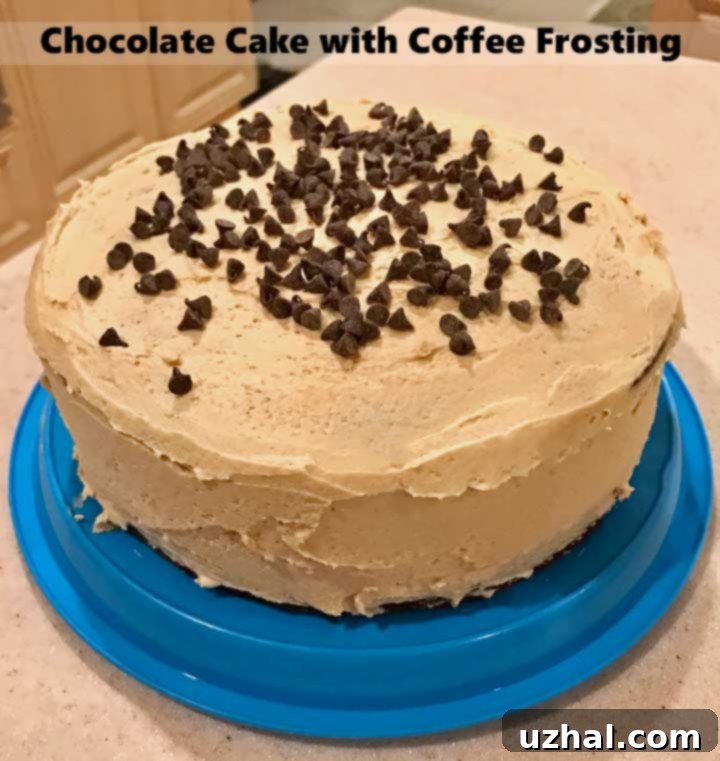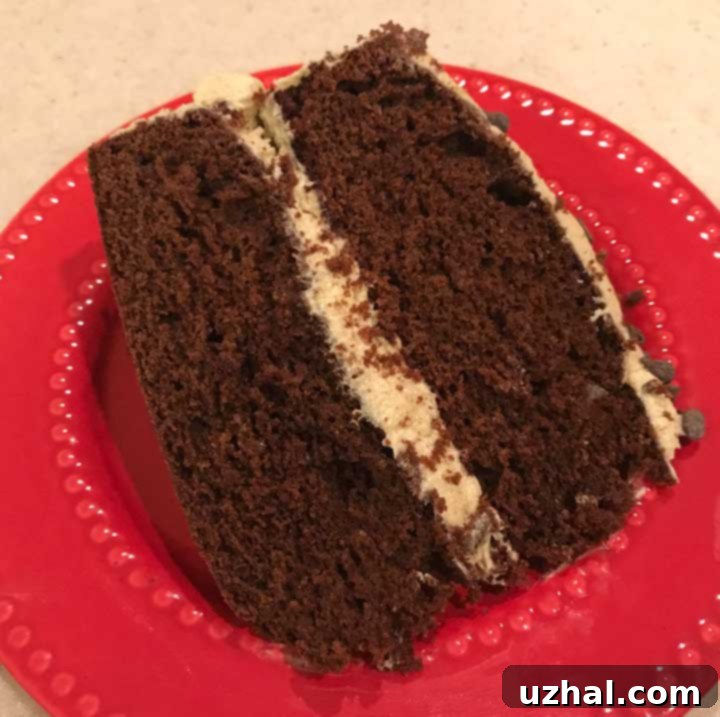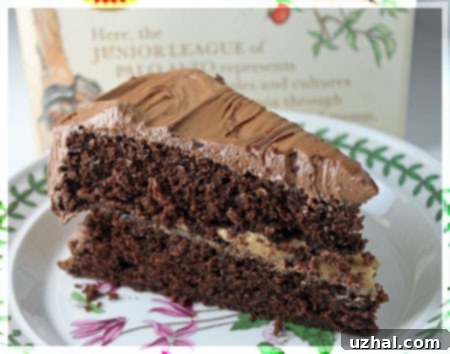The Ultimate Palo Alto Chocolate Cake with Decadent Coffee Frosting: A Timeless Classic
There are chocolate cakes, and then there’s the Palo Alto Chocolate Cake. This exceptional recipe, a true gem from one of my all-time favorite cookbooks, “A Private Collection” by the Junior League of Palo Alto, transcends the ordinary. It’s more than just a cake; it’s a culinary experience, a testament to classic baking techniques, and a delightful journey for any home baker. I’ve had the pleasure of baking and sharing this recipe countless times over the years, experimenting with various frostings, but there’s something truly magical about its original pairing with a rich, aromatic coffee-flavored frosting. While a classic chocolate frosting also pairs beautifully, the coffee nuance elevates this cake to new heights, creating a symphony of flavors that is both comforting and sophisticated.

Unveiling the Secrets of the Palo Alto Chocolate Cake
What makes the Palo Alto Chocolate Cake stand out in a world full of chocolate cake recipes? It’s in the method, the thoughtful sequence of steps that ensures a consistently moist, intensely flavorful, and perfectly textured cake. While some might shy away from a recipe that requires a few more stages than a simple dump-and-mix, I promise you, each step in this process is straightforward and contributes significantly to the final, irresistible result. Think of it not as complexity, but as an engaging project that yields truly rewarding dividends.
The Custard Foundation: A Symphony of Moisture and Flavor
The journey to this extraordinary cake begins with a unique custard mixture. Imagine melting rich unsweetened chocolate and blending it with tangy buttermilk, a touch of granulated sugar, and a single egg yolk. This isn’t just a simple mix; it’s a slow, gentle whisking process over low heat that transforms these humble ingredients into a smooth, thick, pudding-like base. This chocolate custard is the secret weapon of the Palo Alto Chocolate Cake, infusing the batter with an unparalleled depth of chocolate flavor and guaranteeing an exceptionally moist crumb that will stay tender for days. Allowing this mixture to cool ensures it integrates perfectly with the other ingredients, preventing any unwanted curdling and promoting a uniform texture.
The Creamed Mixture: Building Richness and Structure
Next, we move to the classic creaming method. Softened unsalted butter is beaten with packed light brown sugar until light and fluffy. This aeration is crucial for a tender cake. The addition of two egg yolks, one at a time, further enriches the mixture, binding the fats and sugars and adding a beautiful golden hue. This creamy foundation sets the stage for the dry ingredients, providing a stable base that will hold the cake’s structure as it bakes.

The Flour and Buttermilk Dance: Achieving Perfect Texture
The dry ingredients – sifted cake flour, baking soda, and salt – are then gradually incorporated into the creamed mixture, alternating with the remaining buttermilk. The use of cake flour, specifically, is a subtle but important detail. Its lower protein content results in a more tender, delicate crumb compared to all-purpose flour. The baking soda, activated by the buttermilk’s acidity, ensures a perfect rise. Finally, the cooled chocolate custard and a touch of vanilla extract are gently stirred in, bringing all the rich flavors together into a cohesive, luscious batter.
The Grand Finale: Folding in Egg Whites for Airiness
The last step before baking is perhaps the most delicate and impactful: incorporating beaten egg whites. The egg whites, whipped to stiff but not dry peaks, are carefully folded into the batter. This step is essential for creating the characteristic light and airy texture of the Palo Alto Chocolate Cake. The air trapped in the egg whites expands during baking, giving the cake a delightful lift and a melt-in-your-mouth tenderness. It’s crucial to fold them in gently to retain as much air as possible, ensuring no white streaks remain for a uniform, perfect bake. While these steps might seem like a lot, each one is relatively simple and, when followed, guarantees a chocolate cake that is truly a cut above the rest – a fun and deeply satisfying project for any baker.

Crafting the Perfect Coffee Frosting
No Palo Alto Chocolate Cake is complete without its iconic coffee frosting. This buttery, smooth, and intensely flavored frosting provides the perfect counterpoint to the rich chocolate cake. It’s a fantastic recipe on its own, and the beauty of it lies in its adaptability. The original recipe suggests 2-3 tablespoons of instant coffee, which historically often referred to brands like Folgers Crystals. However, if you’re using a more potent instant espresso powder, you’ll likely only need about 1 tablespoon to achieve a robust coffee flavor. This is where your personal preference comes into play – do you prefer a subtle whisper of coffee or a bold, invigorating kick? Don’t hesitate to start with less and gradually add more to achieve your desired intensity. I’m always experimenting with coffee amounts to find new sweet spots, and I encourage you to do the same to tailor it perfectly to your taste buds. The key is to dissolve the coffee in a small amount of boiling water and let it cool completely before incorporating it into the butter and confectioners’ sugar. This ensures a smooth frosting texture without any gritty coffee bits.
The Enduring Legacy of “A Private Collection”
For those who cherish culinary history and enjoy collecting cookbooks, “A Private Collection” by the Junior League of Palo Alto is an absolute treasure. This book isn’t just a collection of recipes; it’s a reflection of a community’s culinary heritage, offering a diverse array of dishes that have graced tables for generations. The Palo Alto Chocolate Cake is just one shining example among many fantastic recipes found within its pages. Tracking down a copy can be a delightful quest for any cookbook enthusiast, and I highly recommend it if you’re looking for time-tested, reliable, and genuinely delicious recipes that evoke a sense of tradition and home. You can find more information about this beloved cookbook here, perhaps even inspiring you to start your own collection!

Recipe: Palo Alto Chocolate Cake with Coffee Frosting
Palo Alto Chocolate Cake with Coffee Frosting
Cookie Madness
Pin Recipe
Ingredients
Custard Mixture
- 5 ounces unsweetened chocolate chopped, for a deep chocolate flavor
- ½ cup buttermilk adds moisture and tenderizes the cake
- 1 cup granulated sugar
- 1 large egg separated – white reserved for later
Creamed Mixture
- ½ cup unsalted butter softened, for easy creaming
- 1 cup light brown sugar packed, adds depth of flavor
- 2 eggs separated — whites reserved for folding
Flour Mixture
- 2 cups sifted cake flour spoon lightly into your cup, don’t pack or weigh out 7 ounces/200 grams, for a tender crumb
- 1 teaspoon baking soda
- ½ teaspoon salt
- ¾ cup buttermilk additional buttermilk for moisture and flavor
- 1 teaspoon vanilla extract enhances chocolate flavor
Coffee Frosting
- 2 tablespoons instant coffee dissolved in about ¼ cup boiling water, then cooled (adjust to taste, 1 tbsp espresso powder if using)
- 3 cups confectioners’ sugar sifted for a smooth frosting
- 2 sticks unsalted butter, softened 230 grams, at room temperature
- ¼ teaspoon salt balances sweetness
- 1 tablespoon vanilla extract enhances overall flavor
Instructions
-
Preheat your oven to 350 degrees F (175 C). Prepare two 9-inch round cake pans by greasing them thoroughly and then dusting with flour, tapping out any excess. This ensures the cakes release easily.
-
Prepare the Custard Mixture: In a medium saucepan, gently melt the chopped unsweetened chocolate over very low heat, stirring frequently to prevent scorching. Once melted, remove from heat and stir in ½ cup of buttermilk. Whisk until the mixture is completely smooth and uniform. Slowly add 1 cup of granulated sugar and the reserved egg yolk from the first egg. Whisk constantly for about 3 minutes, or until the custard visibly thickens and becomes smooth. Transfer the custard to a separate bowl and allow it to cool completely to room temperature. This cooling step is crucial before adding it to the main batter.
-
Assemble the Cake Batter: In a large mixing bowl, using an electric mixer, cream together the softened unsalted butter and the packed light brown sugar until the mixture is light, fluffy, and pale. Beat in the two reserved egg yolks, one at a time, ensuring each is fully incorporated before adding the next. In a separate bowl, re-sift the cake flour with the baking soda and salt. Gradually add the flour mixture to the butter mixture in three alternating additions with the remaining ¾ cup of buttermilk, beginning and ending with the flour mixture. Mix on low speed until just combined after each addition. Finally, gently stir in the completely cooled chocolate custard and the vanilla extract until just incorporated. Do not overmix.
-
Fold in Egg Whites and Bake: In a clean, dry bowl, beat the three reserved egg whites until they form stiff but not dry peaks. Gently fold the beaten egg whites into the chocolate cake batter in two additions. Use a rubber spatula to carefully incorporate the whites, lifting from the bottom of the bowl and folding over the top, taking care not to deflate the mixture. Ensure there are no white streaks left in the batter – this will result in an uneven cake. Pour the batter evenly into the two prepared cake pans. Bake for 25-30 minutes, or until a wooden skewer inserted into the center comes out clean and the cake just begins to pull away from the sides of the pans. Let the cakes cool in the pans for 10-15 minutes before inverting them onto a wire rack to cool completely. Once completely cool, proceed with frosting.
-
Prepare the Coffee Frosting:
-
First, dissolve your instant coffee (or espresso powder) in the boiling water and set aside to cool completely. In a large mixing bowl, beat the softened unsalted butter with the salt using an electric mixer until it is creamy and smooth. Gradually add the sifted confectioners’ sugar to the butter, alternating with the cooled coffee mixture. Begin and end with confectioners’ sugar. Beat and scrape down the sides of the bowl frequently until the frosting is light, creamy, and wonderfully smooth. Finally, beat in the vanilla extract.
Notes
Tips for Baking a Perfect Palo Alto Chocolate Cake
To ensure your Palo Alto Chocolate Cake turns out perfectly every time, here are a few additional tips:
- Room Temperature Ingredients: Always use room temperature butter, eggs, and buttermilk for the best emulsification and a smooth batter. Cold ingredients can cause the batter to curdle and affect the cake’s texture.
- Measure Accurately: Especially with cake flour, spoon it lightly into your measuring cup and level it off. Don’t pack it down, as this can lead to a dry cake. Better yet, use a kitchen scale for precise measurements (7 ounces or 200 grams for the cake flour).
- Don’t Overmix: After adding the dry ingredients and especially after folding in the egg whites, mix only until just combined. Overmixing develops gluten, which can result in a tough, dense cake.
- Cool Completely: Resist the urge to frost a warm cake! Even slightly warm cake layers will melt your beautiful frosting. Ensure they are completely cool to the touch before assembling and decorating.
- Pan Preparation: Properly greasing and flouring your cake pans is essential to prevent sticking. You can also line the bottoms with parchment paper for extra assurance.
- Storage: Store the frosted cake at room temperature in an airtight container for up to 2-3 days, or in the refrigerator for up to a week. Bring to room temperature before serving for the best flavor and texture.
Why You’ll Fall in Love with This Cake
This Palo Alto Chocolate Cake with Coffee Frosting is more than just a dessert; it’s a statement. Its deep, rich chocolate flavor, coupled with the tender, moist crumb, makes it utterly irresistible. The coffee frosting provides a delightful mocha note that enhances rather than overpowers the chocolate, creating a sophisticated balance that appeals to almost everyone. It’s a perfect centerpiece for birthdays, holiday gatherings, or simply as an indulgent treat to brighten any ordinary day. The effort put into its creation is truly reflected in every decadent bite, making it a recipe you’ll return to again and again.
